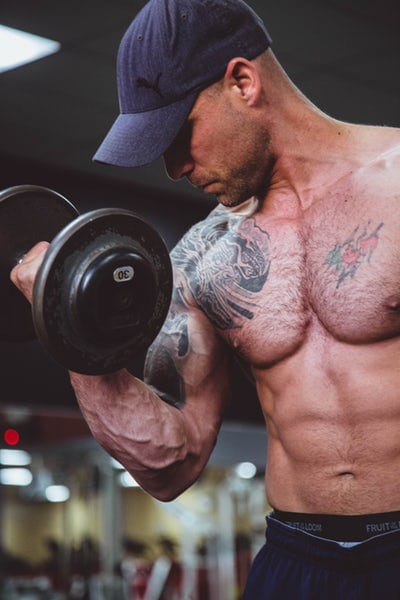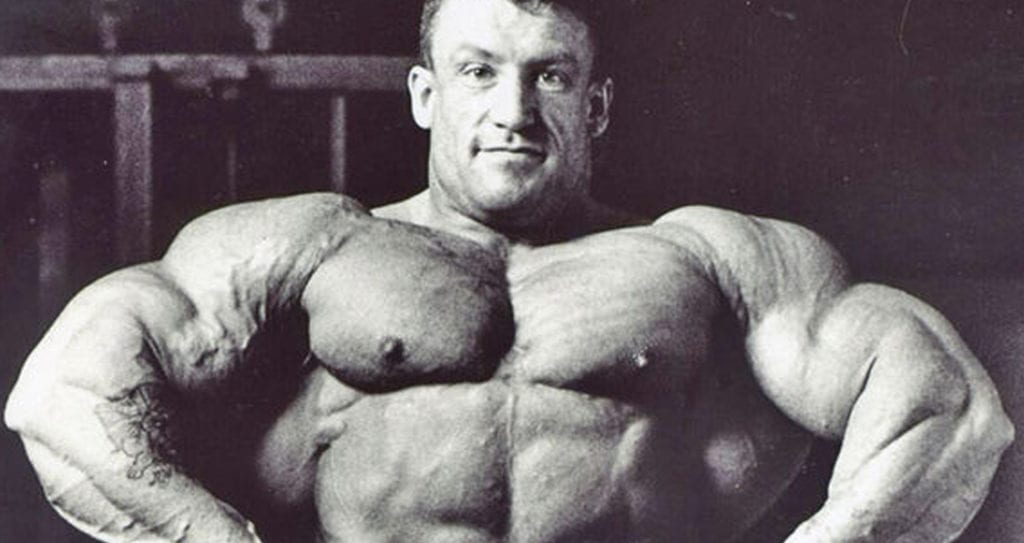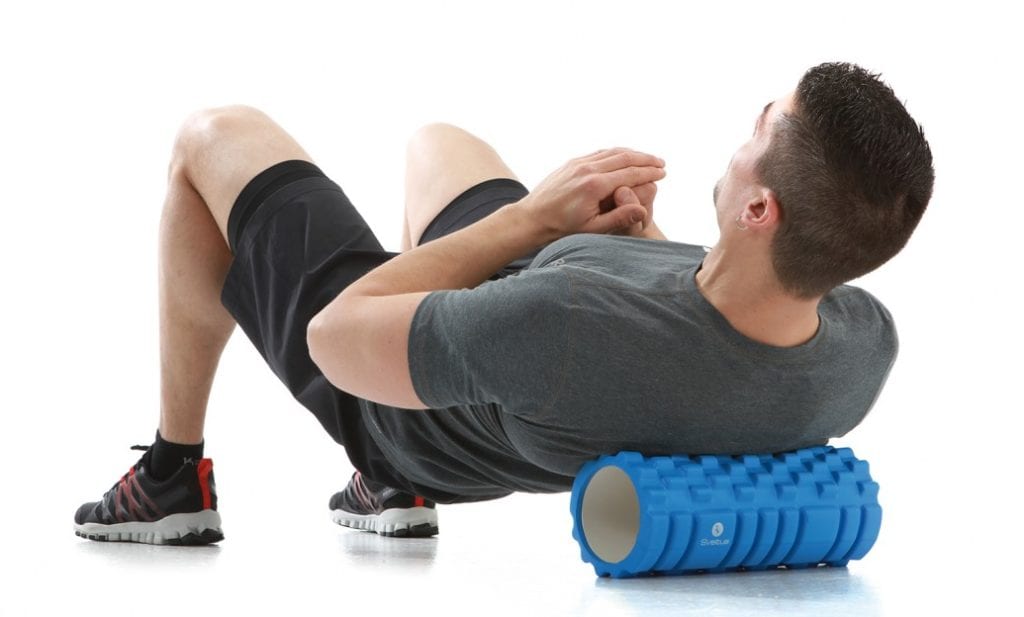Low Volume Weight Training | The Best Way To Add Muscle
14/06/2019
Low Volume Weight Training is one of the best ways to add muscle (if not the best!) in my opinion. I’ve been lifting weights since the age of 14 (i’m 30 now), so i’ve been lifting for 16 years!

I’ve done every type of training program you can imagine: from German Volume Training, High volume, Low volume, pyramid sets, drop sets, rest pause sets, periodisation, sports specific training – when I played Ice Hockey for 7 years, you name it!
All of these styles of training worked in some shape or form, and were useful for the goal I was chasing at the time. That said some are more beneficial than others, especially when it comes to building muscle, and that’s what we’re going to focus on in this post…
Low Volume Weight Training | The Best Way To Add Muscle
In a nutshell low volume weight training is a style of resistance training which involves less sets and reps, but more intensity i.e. heavier weight and going all out every set – it’s something Dorian Yates based his entire training ethos on. We will look at low volume weight training in much more detail very shortly but before we do let’s look at the most common style of weight training…
High Volume Weight Training

This is what most guys and women do, especially the younger generation 18-25 – who are usually either at college or university, or who just generally have more time on their hands (no kids, less responsibilities, etc). I remember when I was at Sheffield Hallam University I used to spend 2hrs in the gym every day, I had the time and motivation and i loved it!
What is high volume training?
In a nutshell high volume weight training is the opposite of low volume training, it’s where you do lots of sets, reps and destroy your muscles with lots of different exercises each workout.
Benefits of high volume resistance training?
There are lots of benefits to doing a high volume weight training program, for example you get a great muscle pump. The more sets and reps you do, the more blood goes into your muscle(s), and the more they swell up. As you will probably know this is called ‘the pump’ – it’s a great feeling and makes your physique look epic (especially if you have big muscles).
This style of training is also what many bodybuilders do, the technical term is called ‘hypertrophy training’ and it’s about inducing cell swelling, getting muscles to expand, and then giving them nutrients to replenish – mainly in the form of protein and carbs.
The disadvantages of high volume training…
Lots of people believe “more is better” – the more we do the better we get… “practice makes perfect” and all that jazz! Whilst in many areas of life this may be true, it does have it’s limitations when it comes to building muscle – there’s only so much your body can handle in one go.
If you went and lifted weights for 10 hours straight you would be ruined! lol!, it wouldn’t be as effective compared to training for 1 hour per day, for 10 days in a row. Your body needs time to recover, and most people’s performance will start to dramatically decline after 30-45 mins, so pushing more than this can be counterproductive.
Lots of people are influenced by magazines such as Mens Health, Flex Magazine and Muscle & Fitness – whom often share high volume programmes done by pro bodybuilders and fitness models. The truth is that most readers aren’t ready for such high volume programmes and need to build up, and to also be aware/appreciate the other aspects of building muscle such as nutrition and rest and recovery strategies (which we will look at later on in this post).
Injury, poor posture, and a decline in strength…
Other negative(s) of high volume training include constantly feeling beaten up! As you cause unnecessary damage to your body with lots of sets and reps, and you are also increasing the likelihood of injury, especially muscular injury, joint paint, and general fatigue. This will negatively impact your bodies ability to build muscle and in many cases it will have the opposite effect, your body will start to burn your muscle, instead of build new tissue.
Another thing I see lots of (and have experienced this myself) is poor posture, lots of guys go and train chest and end up doing 20 sets. What happens is the chest and front deltoids (shoulder muscles) become overly developed and tight, causing the shoulder to round forward. This can lead to a whole host of issues such as shoulder pain, neck strain, headaches, etc.
Low Volume Weight Training

Like I said right at the begging of this post… low volume weight training is far superior to high volume training in my opinion. This is providing you are injury free and take good care of your body. If you are highly stressed, over worked and have lots of muscular imbalances or health conditions then I wouldn’t recommend going into a low volume weight training program, unless the focus is on recovery i.e. deload training, and the intensity is pulled back to allow the body to heal.
Dorian Yates | Low Volume Weight Training

One of the best bodybuilders of our time Dorian Yates based his training ethos on a low volume approach. He would lift heavy and annihilate every set, taking both his mind and body to new heights. This is evident in his freakishly dense muscle mass.
Benefits of low volume resistance training?
There are lots of benefits to low volume lifting, such as it takes less time to complete a workout, training is more intense and sets are less. Most sessions aren’t going to last longer than 45 mins (and if they do you’re probably not pushing yourself hard enough). Instead of doing 8-20 sets per muscle (like with a high volume approach) you only do 2-3 sets per muscle. So it’s good for those of you who don’t have much time to train.
It’s also the best way to build muscle because you can put all of your strength into each and every set. You’re not trying to pace yourself like with high volume training. Instead, you know you’ve only got 2-3 sets and you’ve got to make them count… so you push it and maximise each set. It’s a great way to get strong and build muscle.
Low volume weight training is also extremely satisfying, as you lift heavy it makes you feel euphoric, as testosterone and feel good hormones surge around your body.
The disadvantages of low volume training…
Like with all training styles/programmes there are both pro’s and con’s to each method. The negative side of low volume training is that it’s super stressful on the joints and muscles. Dorian Yates’s career was cut short due to injury from brutal training.
Low volume training is extremely taxing on the CNS (central nervous system) and can leave you feeling knackered, drained of energy and in a bad way, especially if you don’t manage your recovery properly with good nutrition, sleep, foam rolling and mobility.
While low volume weight training can be extremely effective, there are lots of other ways to build muscle, for example: German volume training, PHUL training, TUT (time under tension), German body composition training, and DTP training… to name but a few other effective methods.
What does a low volume training program look like?
There are lots of variations and ways to set up a low volume resistance training plan, this is an example of what I use…
Monday – Upper Body (1)
- Barbell row x 6-10 reps – 1 warm up set, 2 intense sets
- Flat bench press x 6-10 reps – 1 warm up set, 2 intense sets
- DB curls – x 6-10 reps – 1 warm up set, 2 intense sets
- DB skull crushers x 6-10 reps – 1 warm up set, 2 intense sets
- DB Arnold press x 6-10 reps – 1 warm up set, 2 intense sets
Tuesday – Lower Body (1)
- Romanian deadlift x 6-10 reps – 1 warm up set, 2 intense sets
- DB lunges x 6-10 reps (each leg) – 1 warm up set, 2 intense sets
- Leg press – x 6-10 reps – 1 warm up set, 2 intense sets
- Leg press calf raises x 20-25 reps, 2 intense sets
Wednesday – REST
Thursday – Upper Body (2)
- Wide pull ups x 6-10 reps – 1 warm up set, 2 intense sets
- Incline DB press x 6-10 reps – 1 warm up set, 2 intense sets
- Barbell curls – x 6-10 reps – 1 warm up set, 2 intense sets
- Dips x 6-10 reps – 1 warm up set, 2 intense sets
- DB shrugs x 10-15 reps – 1 warm up set, 2 intense sets
Friday – Lower Body (2)
- Lying hamstring curl x 6-10 reps – 1 warm up set, 2 intense sets
- Front squats x 6-10 reps – 1 warm up set, 2 intense sets
- Bulgarian squats – x 6-10 reps (each leg) – 1 warm up set, 2 intense sets
- Smith machine calf raises x 20-25 reps, 2 intense sets
Saturday and Sunday – REST
Each workout i’m only doing 6-10 intense sets. I typically rest in between sets for 2 mins on big compound lifts like the rows and bench press, but then only rest 1 min for more isolation style moves like DB curls and skull crushers.
Recovering from low volume weight training…

The are lots of ways to ensure the best recovery from this style of training, the one’s that help me and the one’s that I recommend to my one to one personal training clients are…
Sleep
The most important (and underrated!) aspect of recovery. You need to be aiming for at least 7 hours of sleep per night (ideally 8). There’s a great book which i’d recommend reading called ‘Why We Sleep’ by Matthew Walker.
Some tips to improve sleep include: going to bed at a set time each night, making sure your room is dark, turning off all technological devices 2 hours before bed (TV, phone, laptop, etc). You could also try sleep sups like magnesium and zinc – I’m a big fan of these for overall recovery.
Nutrition
If building muscle is your main aim then protein is king. You need to be consuming at least 2g (ideally 2.5-3g) of protein per kg of bodyweight.
Alongside protein you also need a good amount of carbs. On training days I like to go for high protein and carbs, with low fat. On rest days I recommend high protein, medium fat, low carbs. This is also known as ‘carb cycling’ and it’s a great strategy to use for muscle building as it improve insulin sensitivity.
Foam rolling
A great tool to use to iron out tight muscle tissue and break up tight muscle fascia – a web of enmeshed muscle which is tight, has poor blood flow and negatively impacts training performance. I recommend foam rolling before training and after training (for 5-10 mins) here are some of the exercises I do with my clients…
Stretching
Important for loosing off tight muscles. For me (like lots of other people) I really struggle with tight shoulders, pecs, and hamstrings. Stretching at the end of your session helps to improve the length of the muscle. Here are the stretches that I do…
Mobility
After foam rolling for 5-10 mins, I always spend a couple of minutes doing mobility drills before I train, especially when i’m doing heavy compound lifts like the bench press, deadlift, squat, pull ups, etc. Here are some excellent mobility drills you can do to keep your body healthy…
Deload Weight Training
Every 6-12 weeks you will likely need to back off training intensity to let your body recover. When it comes to building muscle think “two steps forwards one step back” – you push hard for a period of time, but then pull back.
At the moment every 8 weeks, I take one week where I half my weights and training volume and let my body chill. I have baths every night, foam roll, stretch, mobilise, I also focus on reducing my workload in general i.e. less personal training sessions, less blogging, etc – it’s time needed for me to recover. For a full post on deload weight training please visit here.
Thanks for reading, if you found this post helpful please leave your comment below or drop me a message at nick@lepfitness.co.uk
Thanks again,

Nick 🙂
About the Author
Sheffield personal trainer Nick Screeton is the owner and founder of LEP Fitness, a personal training company located in Sheffield. To date Nick has completed over 10,000 coaching sessions and has a wealth of experience with a wide variety of clients. Nick helps people achieve their goals, whether that’s building muscle, losing weight (or both!). He can also help improving sporting performance, as he comes from a sporting background, having played college Ice hockey in Canada, and having also completed professional sports coaching courses.